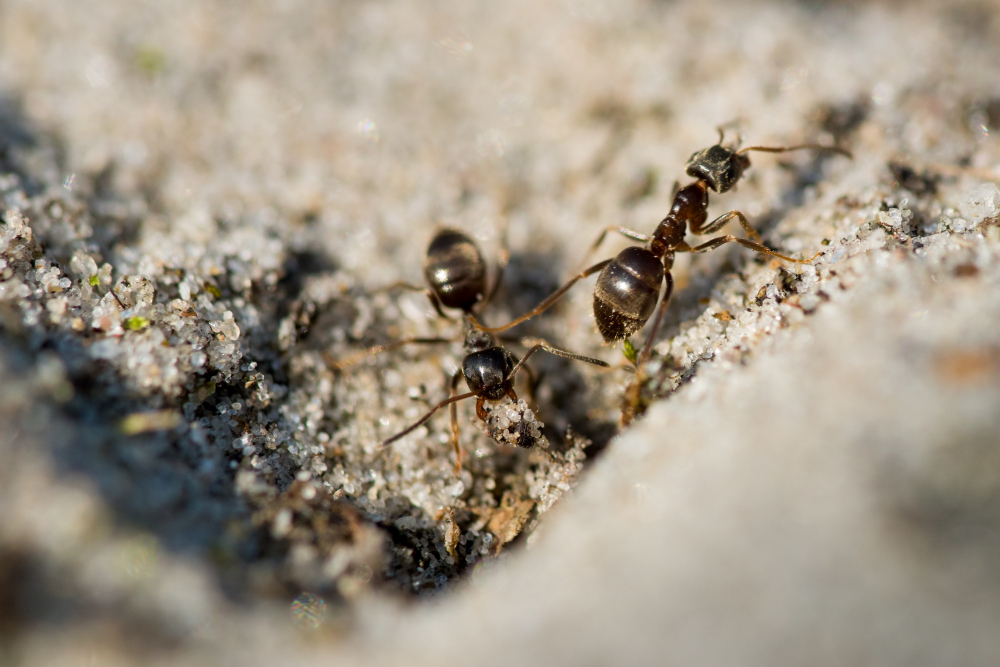Ants are often thought of as minor household nuisances, appearing in kitchens or around windows in search of crumbs. However, not all ants are harmless. Some species, especially carpenter ants, can silently undermine the structural integrity of your home. While they don’t eat wood like termites, certain ants hollow it out to build their nests, causing gradual but serious damage over time.
Understanding the impact of an ant infestation is crucial for protecting your property. In this article, we’ll explain how ant activity threatens your home’s structural elements, the warning signs to watch for, and the steps you can take to limit their damage. We’ll also discuss why routine pest inspections are one of the smartest investments a homeowner can make.

Why Certain Ants Are Structurally Damaging
Not all ants pose the same risk. Most species are foragers and nest outdoors, occasionally invading your home for food or water. But carpenter ants behave very differently. These ants prefer moist or decaying wood, making them especially problematic in homes with hidden leaks or damp basements.
Key traits of carpenter ants that cause structural concern:
- Wood nesting: Carpenter ants excavate galleries inside wood to house their colonies, weakening beams, joists, and structural framing.
- Multiple colonies: A primary colony is often supported by satellite nests, making infestations harder to control and more damaging over time.
- Preference for moisture-damaged wood: Softened wood in crawl spaces, window sills, or roof overhangs is particularly vulnerable.
If you’re not familiar with what makes carpenter ants such a serious structural threat, it’s important to understand how their behavior differs from other ant species. Unlike ants that simply forage for food, carpenter ants hollow out wood to build their nests, weakening key parts of your home in the process.
Hidden Areas Where Damage Occurs
Because ants often operate inside walls, under floors, or in attics, their presence can go unnoticed until damage is advanced. Recognizing where they commonly build their nests can help homeowners take preventative action before repairs become costly.
Key nesting and damage zones include:
- Wall voids and baseboards: Carpenter ants frequently tunnel behind drywall and into wooden studs.
- Roof eaves and attic beams: Leaky roofs offer moisture-rich wood that attracts nesting colonies.
- Decks and porches: Exterior structures made of untreated wood are common entry points and early nesting zones.
- Window and door frames: These areas tend to retain moisture, especially if improperly sealed.
Unchecked, an ant infestation in these locations can lead to sagging floors, cracked drywall, and even compromised load-bearing structures. The earlier the signs are spotted, the better the chances of preserving the integrity of your home.
Warning Signs You Shouldn’t Ignore
Catching an ant infestation early is essential. Here are several warning signs that could point to ants damaging your home’s structure:
- Rustling or faint tapping sounds coming from inside the walls or ceilings
- Hollow-sounding wood when tapped, especially in baseboards or trim
- Sawdust-like debris (frass) accumulating near baseboards or wall junctions
- Visible worker ants traveling in trails along walls, especially at night
- Shed wings near window sills, a sign of swarming behavior
If you notice any of these indicators, it’s best to assume there’s activity happening behind the scenes and take action before more extensive structural issues develop.
Why DIY Efforts Often Fall Short
Homeowners may attempt to eliminate ants with bait stations or sprays, but these efforts often target foraging ants rather than the nest itself. Carpenter ants in particular require more strategic control methods because of their ability to maintain multiple colonies and avoid surface-level treatments.
Here’s why professional help is often necessary:
- Satellite colonies are difficult to locate without specialized tools.
- Improper pesticide use can scatter ants instead of eliminating them, causing colonies to branch out further.
- Hidden structural access points may remain untreated, allowing reinfestation.
Ant infestations also signal broader vulnerabilities within your home. Cracks, moisture buildup, or compromised materials that invite ants could be affecting other pests as well. That’s why this guide on the importance of regular inspections highlights how routine checks catch small issues before they become major problems.
Steps to Protect Your Home Long-Term
Preventing structural damage from ants requires a comprehensive, long-term plan. Below are key recommendations to minimize risk:
- Eliminate moisture sources: Repair leaks in roofs, pipes, and crawl spaces to make your home less attractive to carpenter ants.
- Seal exterior gaps: Close entry points around windows, doors, and utility lines with caulk or mesh.
- Trim trees and bushes: Keep vegetation from touching your house, which creates bridges for ants.
- Store firewood away from your home: Wood piles can host colonies that eventually migrate indoors.
- Schedule professional inspections: Annual or seasonal assessments help detect early signs before damage spreads.
While these efforts can significantly reduce the risk of infestation, only a licensed pest control provider can confirm the full extent of activity and apply tailored treatments that resolve the problem at its source.
Don’t Let Ants Undermine Your Foundation
Your home’s structural integrity is too important to leave to chance. If you’ve noticed ant activity or signs of hidden damage, now is the time to act. For a detailed inspection and professional plan of action, contact Fisher’s Pest Control. Our experienced team can identify the type of infestation, assess affected areas, and implement safe, effective solutions to protect your property from long-term harm.





